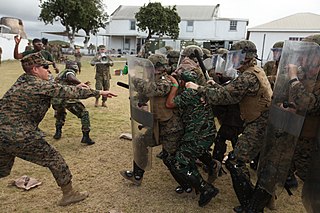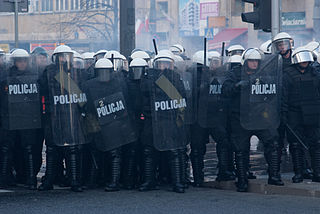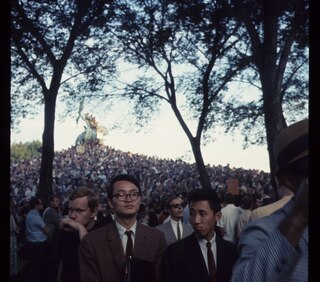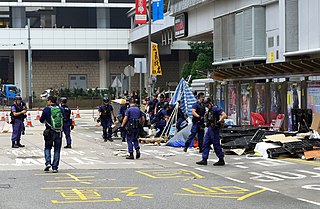
The Riot Act, sometimes called the Riot Act 1714 or the Riot Act 1715, was an act of the Parliament of Great Britain which authorised local authorities to declare any group of 12 or more people to be unlawfully assembled and order them to disperse or face punitive action. The act's full title was "An Act for preventing tumults and riotous assemblies, and for the more speedy and effectual punishing the rioters", and it came into force on 1 August 1715. It was repealed in England and Wales by section 10(2) and Part III of Schedule 3 of the Criminal Law Act 1967. Acts similar to the Riot Act passed into the laws of British colonies in Australia and North America, some of which remain in force today.

Non-lethal weapons, also called nonlethal weapons, less-lethal weapons, less-than-lethal weapons, non-deadly weapons, compliance weapons, or pain-inducing weapons are weapons intended to be less likely to kill a living target than conventional weapons such as knives and firearms with live ammunition. It is often understood that unintended or incidental casualties are risked wherever force is applied, but non-lethal weapons try to minimise the risk of casualties as much as possible. Non-lethal weapons are used in policing and combat situations to limit the escalation of conflict where employment of lethal force is prohibited or undesirable, where rules of engagement require minimum casualties, or where policy restricts the use of conventional force. These weapons occasionally cause serious injuries or death; the term "less-lethal" has been preferred by some organizations as it describes the risks of death more accurately than the term "non-lethal", which some have argued is a misnomer.
Civil disorder, also known as civil disturbance, civil unrest, or social unrest, is a situation arising from a mass act of civil disobedience in which law enforcement has difficulty maintaining their authority.

Riot control measures are used by law enforcement, military, paramilitary or security forces to control, disperse, and arrest people who are involved in a riot, unlawful demonstration or unlawful protest.

A long-range acoustic device (LRAD), acoustic hailing device (AHD) or sound cannon is a specialized loudspeaker that produces sound at high power for communicating at a distance. It has been used as a method of crowd control, which has caused permanent hearing damage, having an extremely high decibel capacity. Other uses have included for negotiations in siege situations to deal with piracy at sea; for mass notification during natural disasters or other emergencies; and by defense forces, including several navies.
The Miami model are the tactics employed by coordinated law enforcement agencies during demonstrations in Miami, Florida relating to the negotiations for the Free Trade Area of the Americas (FTAA) trade agreement in November 2003. The same tactics were first developed and tested at the 2000 Republican National Convention in Philadelphia, Pennsylvania under the direction of John Timoney, who served as police chief to Philadelphia during the RNC and Miami during the FTAA.

Mounted police are police who patrol on horseback or camelback. Their day-to-day function is typically picturesque or ceremonial, but they are also employed in crowd control because of their mobile mass and height advantage and increasingly in the UK for crime prevention and high visibility policing roles. The added height and visibility that the horses give their riders allows officers to observe a wider area, and it also allows people in the wider area to see the officers, which helps deter crime and helps people find officers when they need them. When employed for crowd control, there is a risk that some people may be trampled. Due to this, authoritarian regimes often use mounted police to suppress protests, as the public generally does not view these "accidental" deaths as resulting from a deliberate use of deadly force. In at least one case this has resulted in the police officer riding the horse to be sued.

A police riot is a riot carried out by the police; more specifically, it is a riot that police are responsible for instigating, escalating or sustaining as a violent confrontation. Police riots are often characterized by widespread police brutality, and they may be done for the purpose of political repression.

Riot police are police who are organized, deployed, trained or equipped to confront crowds, protests or riots.

The 1968 Democratic National Convention protests were a series of protest activities against the Vietnam War that took place prior to and during the 1968 Democratic National Convention.

"Skunk" is a malodorant, non-lethal weapon used for crowd control by the Israel Defense Forces (IDF) and marketed to militaries and law enforcement around the world. It was developed and is manufactured by Odortec, with two supporting companies, Man and Beit-Alfa Technologies. The liquid's strong odor is marketed as an improvement over other crowd control weapons (CCWs) such as rubber bullets and tear gas used by the IDF against Palestinian protestors. The IDF is criticized for its tactics during deployment, including common use against people, businesses, and neighborhoods not involved in protests as a form of collective punishment.
In July 1981, the inner-city district of Moss Side in Manchester, England, was the scene of mass protesting. The protests at Moss Side started at the local police station and later moved into the surrounding streets over two days. Key factors seen as fuel for this protest were racial tension, due to frequent allegations of police officers racially abusing and using excessive force against black youths in the area, and mass unemployment brought on by the early 1980s recession. Unemployment was at a post-war high across the nation during 1981, but was much higher than the national average in Moss Side.

The militarization of police is the use of military equipment and tactics by law enforcement officers. This includes the use of armored personnel carriers (APCs), assault rifles, submachine guns, flashbang grenades, sniper rifles, and SWAT teams. The militarization of law enforcement is also associated with intelligence agency–style information gathering aimed at the public and political activists and with a more aggressive style of law enforcement. Criminal justice professor Peter Kraska has defined militarization of police as "the process whereby civilian police increasingly draw from, and pattern themselves around, the tenets of militarism and the military model".

A blast ball, also known as a tear gas ball, rubber ball grenade, or stinger grenade, is a ball-shaped, rubber coated, less-lethal grenade designed for law enforcement and riot control applications. A blast ball is similar to a stun grenade in that, when detonated, it generates a loud noise and bright light; however, it also releases a chemical irritant and occasionally also rubber pellets or fragments.

The Special Tactical Contingent, nicknamed the "Raptors", commonly known as the Special Tactical Squad (STS), is a specialist riot contingent of the Hong Kong Police Force under the command of the Police Tactical Unit (PTU).

Crowd control in Jammu and Kashmir is a public security practice to prevent and manage violent riots. It is enforced by police forces through laws preventing unlawful assembly, as well as using riot control agents such as tear gas, chili grenades, and pellet guns.
"When the looting starts, the shooting starts" is a phrase originally used by Walter E. Headley, the police chief of Miami, Florida, in response to an outbreak of violent crime during the 1967 Christmas holiday season. He accused "young hoodlums, from 15 to 21", of taking "advantage of the civil rights campaign" that was then sweeping the United States. Having ordered his officers to combat the violence with shotguns, he told the press that "we don't mind being accused of police brutality". The quote may have been borrowed from a 1963 comment from Birmingham, Alabama police chief Bull Connor. It was featured in Headley's 1968 obituary published by the Miami Herald.
Starting in May 2020, protests following the murder of George Floyd were held in the city of Portland, Oregon, concurrent with protests in other cities in the United States and around the world. By July 2020, many of the protests, which had been held every day since May 28, drew more than 1,000 participants. Protests continued into August, September, and October 2020, often drawing hundreds.
This is a list of George Floyd protests in Alabama, United States. Protests occurred in fourteen various communities in the state.

Protests and civil disorder occurred in reaction to the killing of Daunte Wright on April 11, 2021. Wright, a 20-year-old Black man, was fatally shot by police officer Kimberly Potter during a traffic stop in Brooklyn Center, Minnesota, United States. Protests that first began in Brooklyn Center spread to other locations in the Minneapolis–Saint Paul metropolitan area and then to other cities in the United States. Several nights of civil disorder in Brooklyn Center and adjacent cities resulted in sporadic looting and damage to a few hundred properties, including four businesses that were set on fire.














